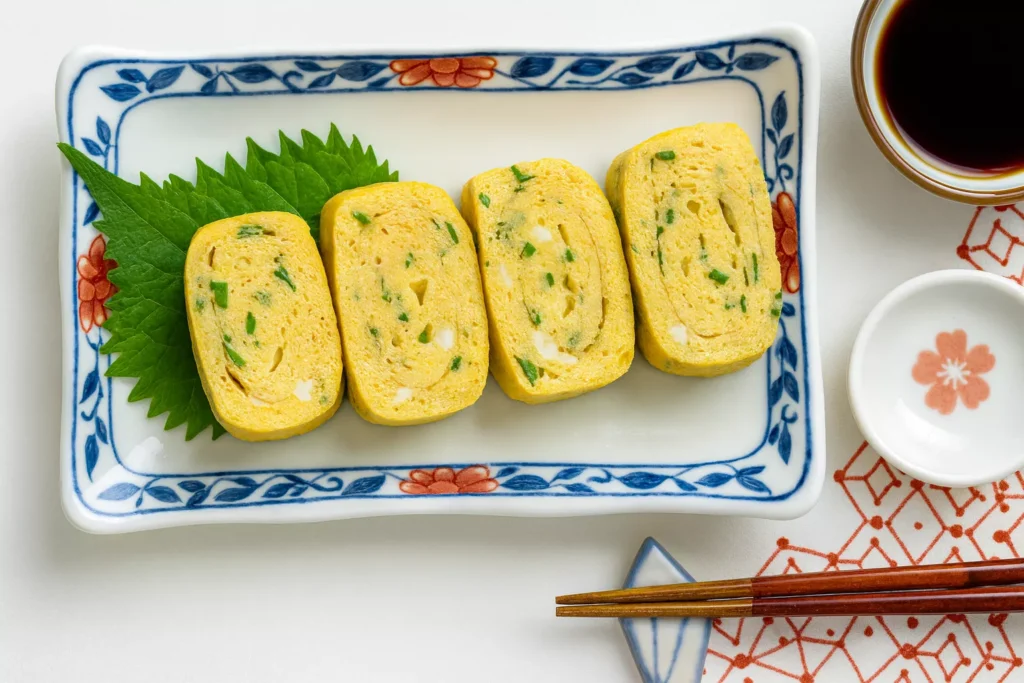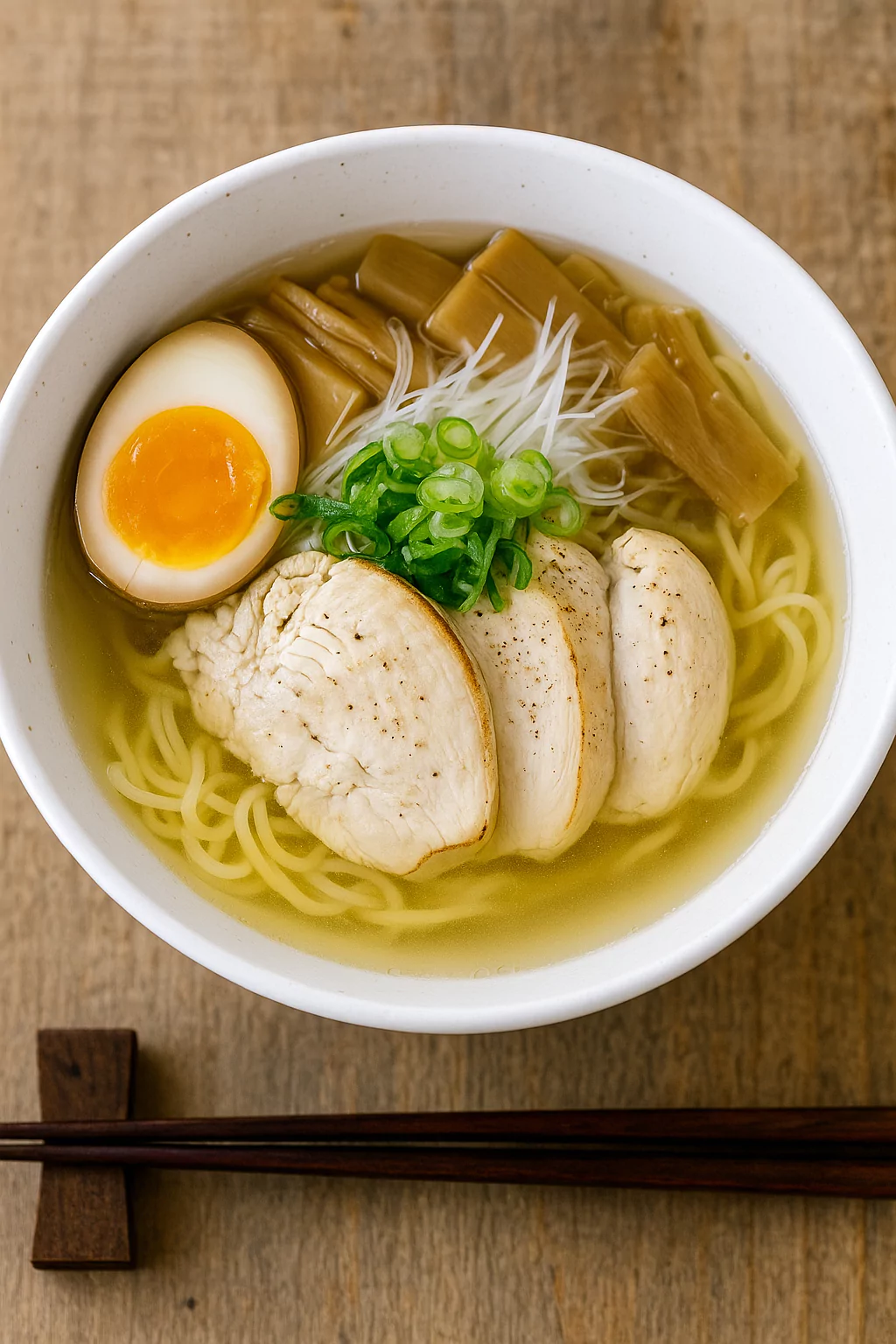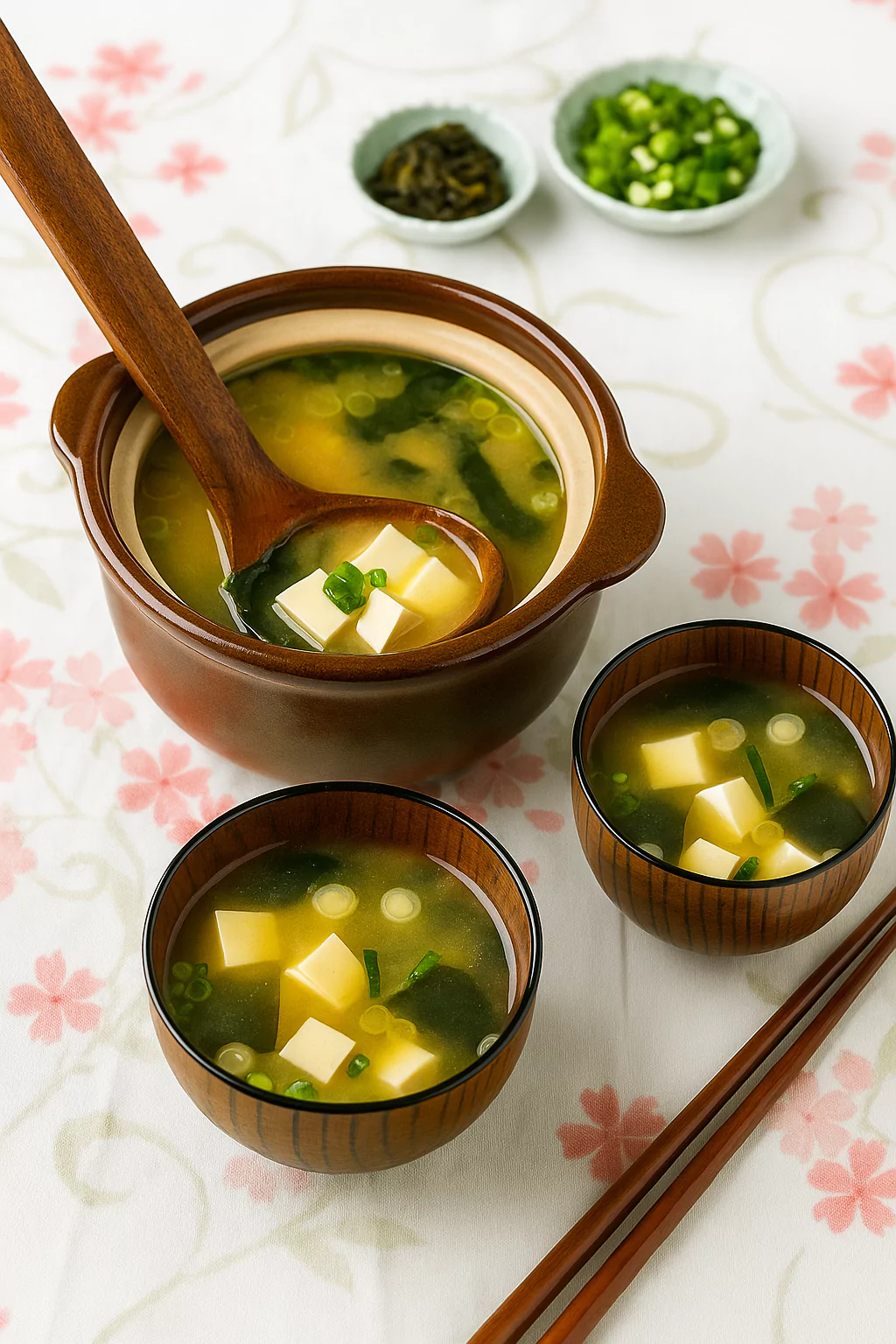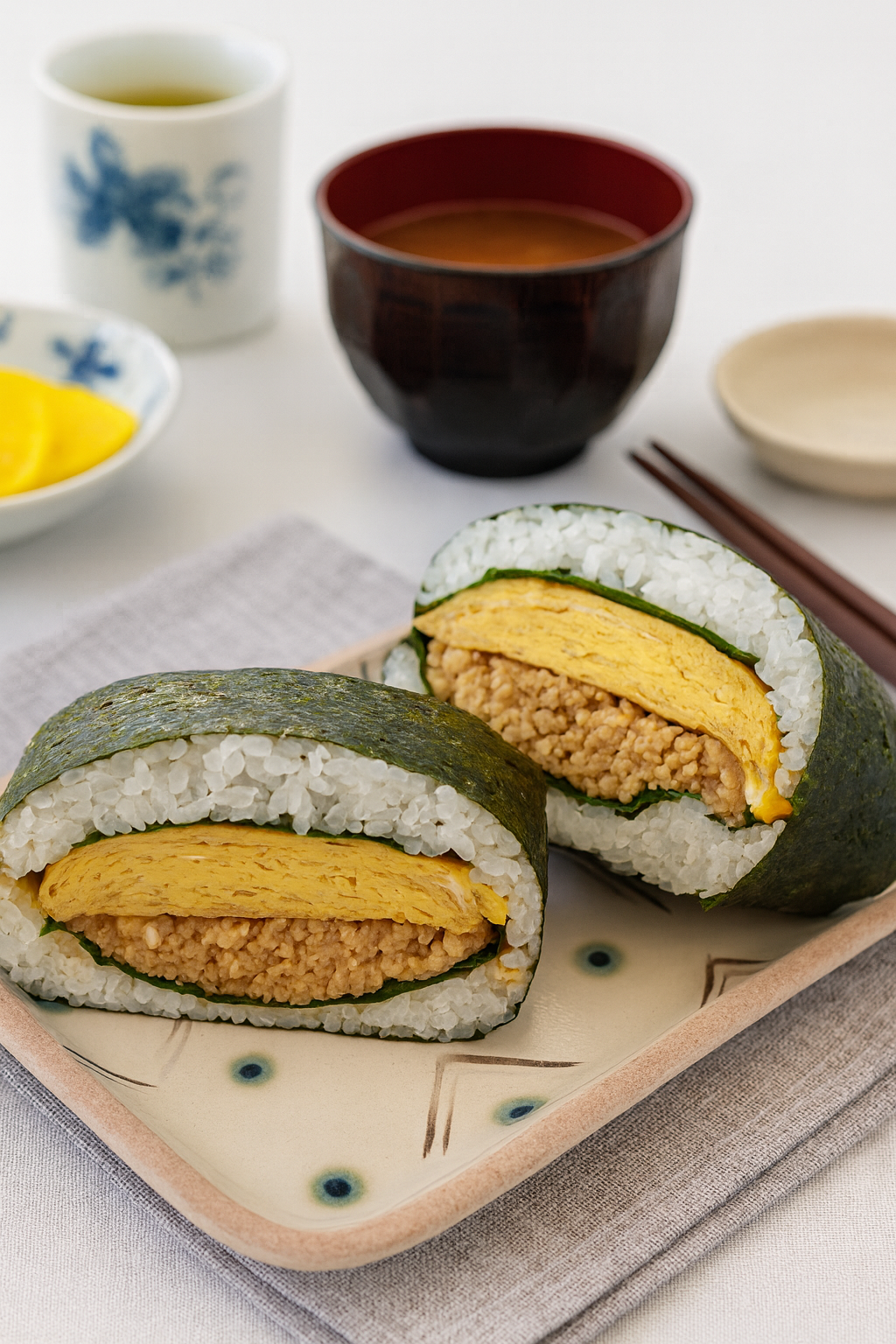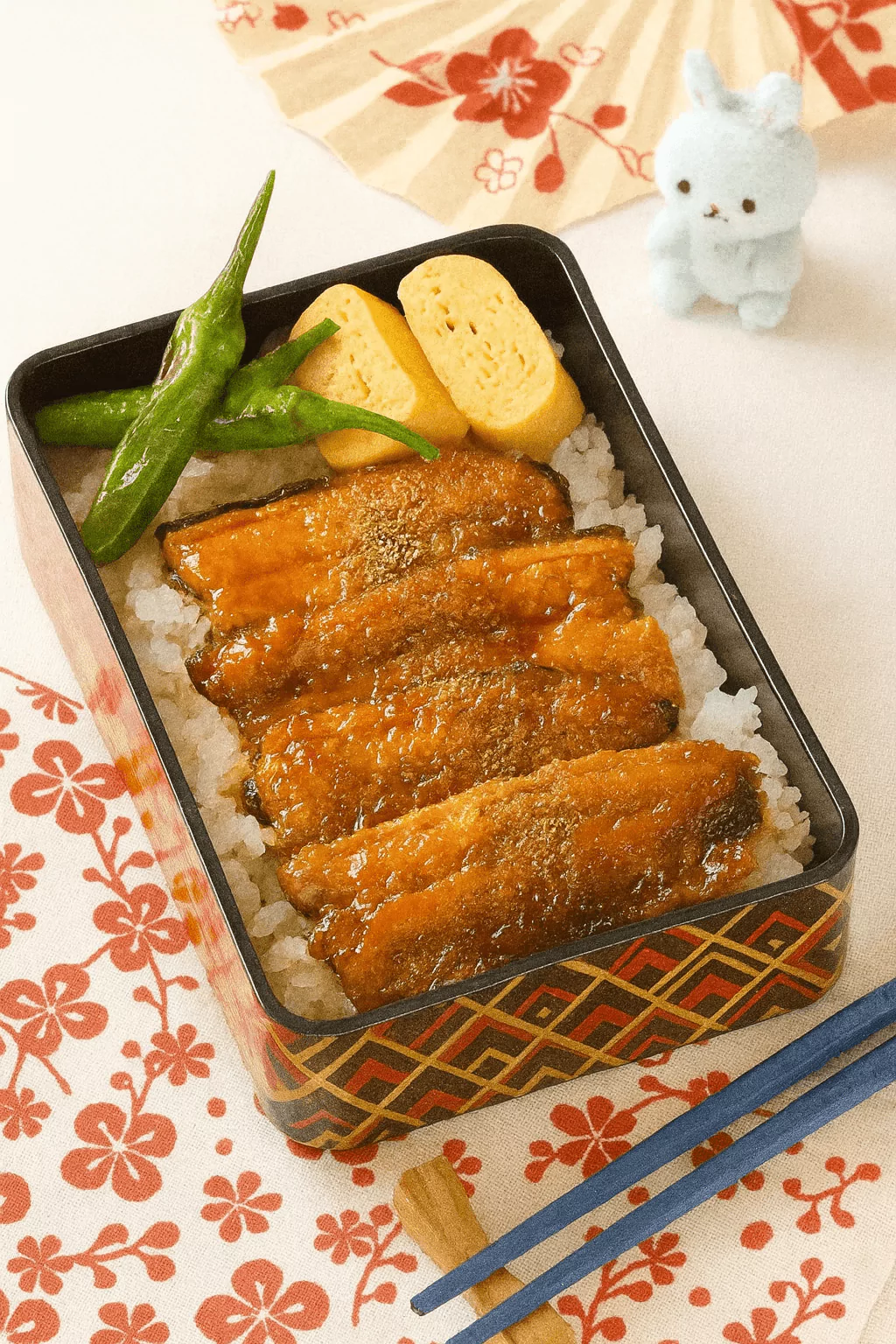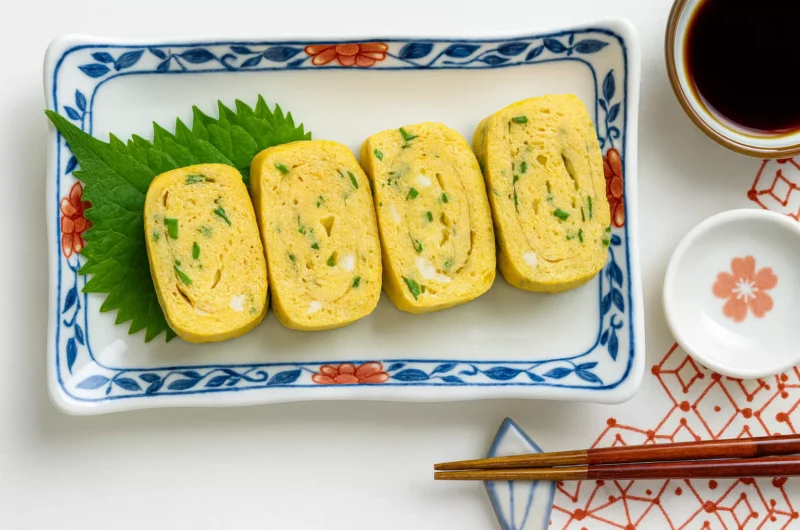Have you ever wondered how Japanese chefs create those beautifully layered, slightly sweet, golden egg rolls that look almost too perfect to eat? Many people think this dish requires years of training or special tools. But here’s the truth: you can make Tamagoyaki (玉子焼き) right at home, even if you’re a beginner.
This article will guide you step-by-step on how to make Tamagoyaki, Japan’s famous rolled omelet, using simple ingredients and easy techniques. Whether you’ve tasted it in sushi, at a Japanese breakfast, or in a bento box, this version will help you master that soft, flavorful texture everyone loves.
What Makes This Recipe Special
Tamagoyaki (玉子焼き) is a traditional Japanese omelet that’s rolled in thin layers to form a soft, slightly sweet, and savory block of eggs. It’s often served as part of Japanese breakfasts, sushi toppings, or lunch boxes. Unlike Western omelets that are flat and fluffy, Tamagoyaki has delicate layers and a moist texture that melts in your mouth.
This recipe is quick, light, and comforting—perfect for any time of day. It only takes about 15–20 minutes from start to finish, and once you get the hang of rolling, it’s surprisingly easy to make.
The difficulty level is beginner-friendly. All you need is a small nonstick pan (a rectangular Tamagoyaki pan works best), a spatula or chopsticks, and a bit of patience. With a few tips and the right proportions, you’ll be making restaurant-style Tamagoyaki in no time.
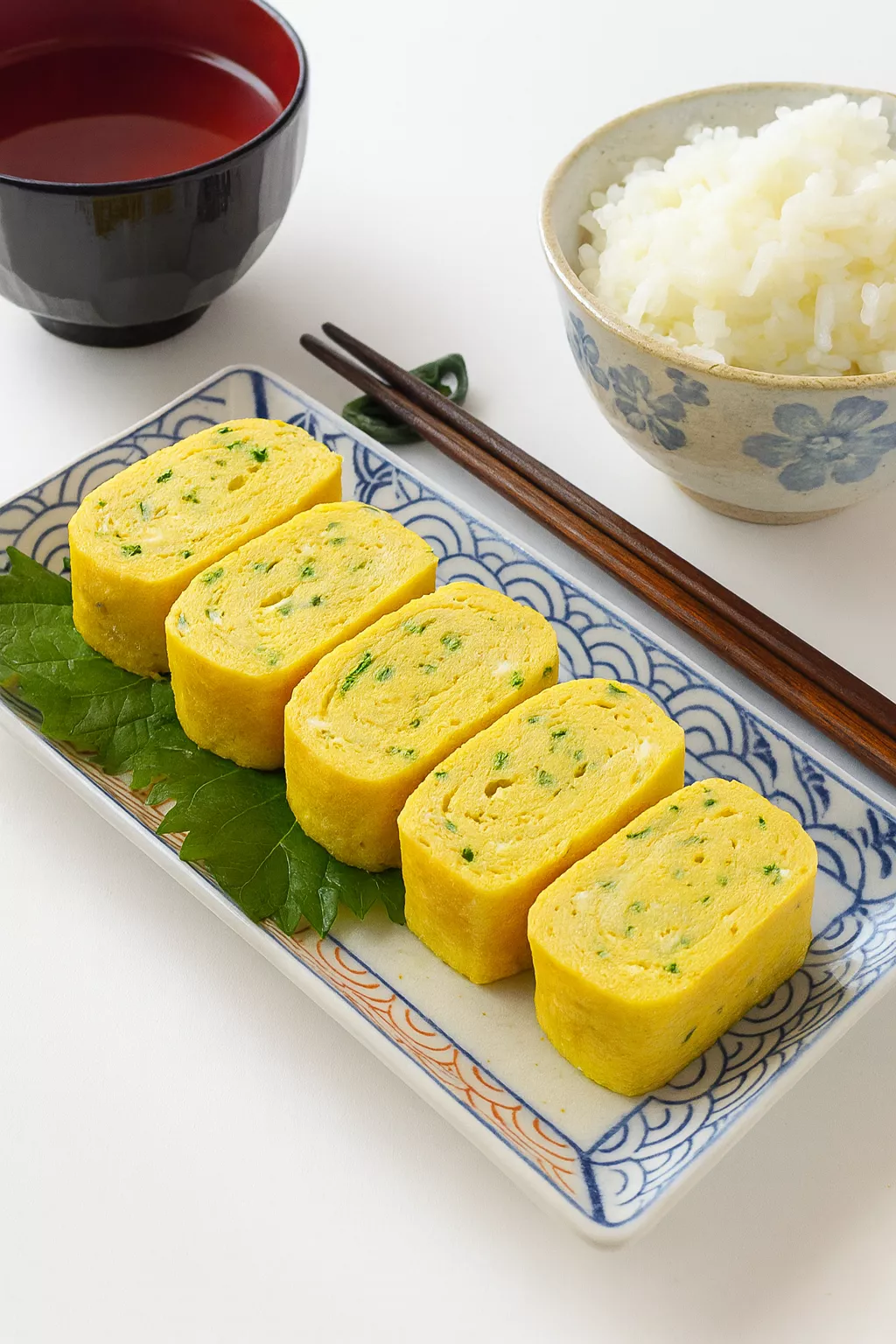
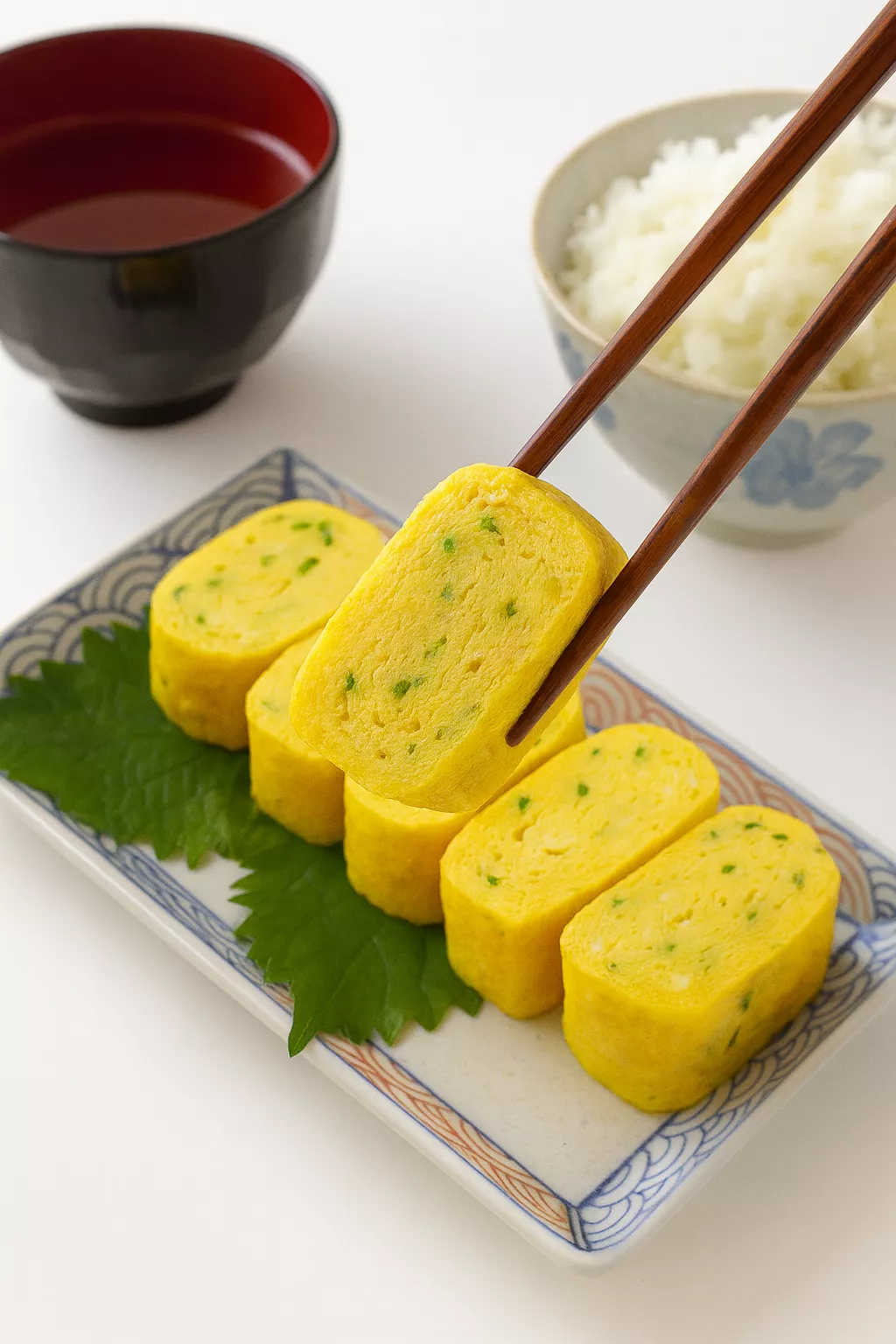
Tamagoyaki 玉子焼き @JapanDishes
What Is Tamagoyaki (玉子焼き)?
The name Tamagoyaki literally means “grilled egg” in Japanese (tamago = egg, yaki = grilled or fried). It’s made by cooking thin layers of seasoned egg mixture and rolling them together while still slightly soft. The flavor depends on the seasoning—some are sweet (with sugar and mirin), while others are savory (using soy sauce and dashi).
In this recipe, we’ll use mayonnaise, mirin, and white dashi for a soft, rich flavor and include shiso (perilla) leaves to add freshness and a hint of herbal aroma. This combination creates a perfect balance between sweet, salty, and umami.
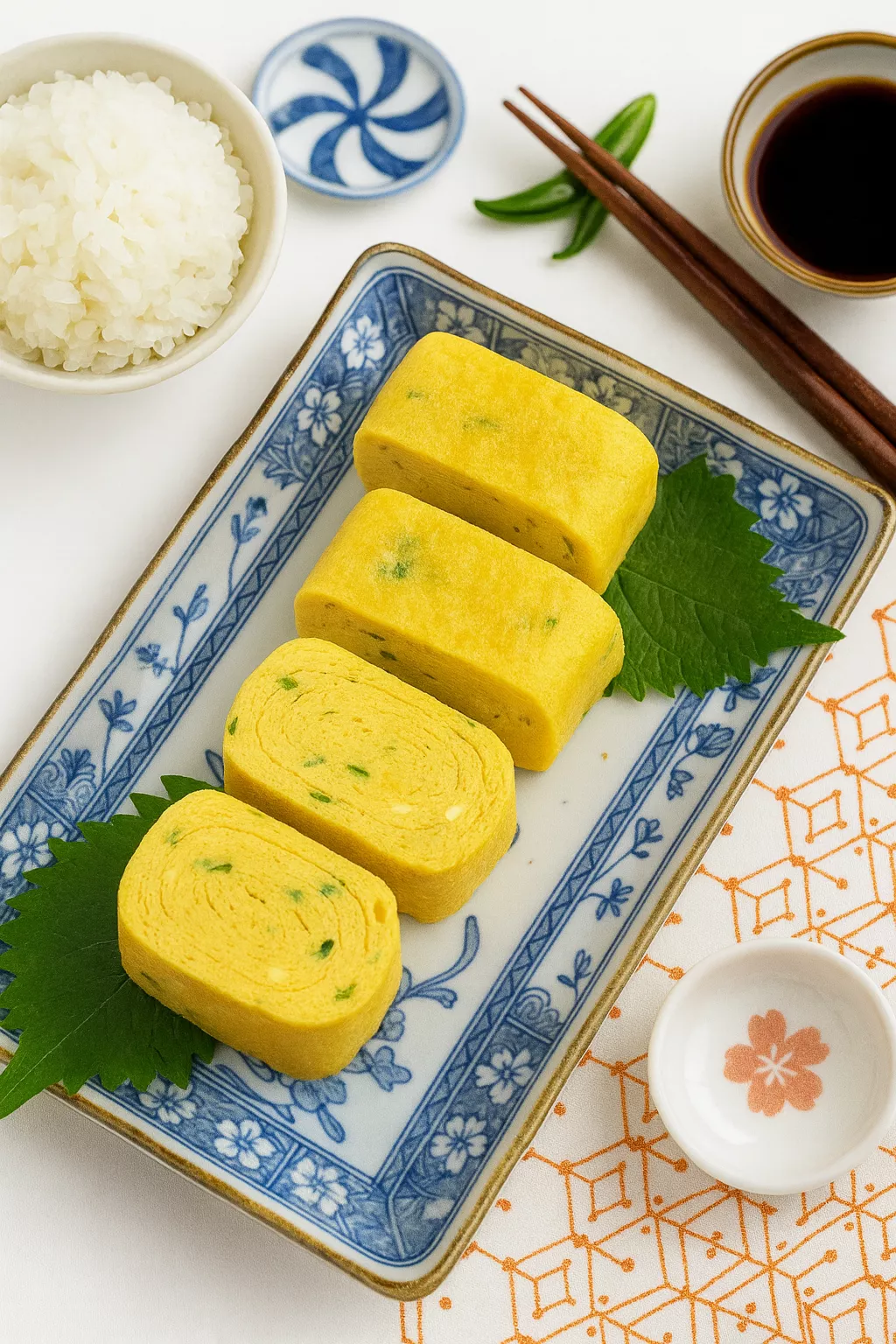
Easy Japanese Rolled Omelet Recipe
Jump to Recipe Print RecipeEssential Ingredients
Main Ingredients
- Eggs (M size) – 2 pieces
The base of Tamagoyaki. Medium eggs create the right balance of fluffiness and firmness. You can use large eggs if preferred—just slightly increase the seasoning. - Mayonnaise – 1 tablespoon
This may surprise you! Mayonnaise adds creaminess and helps the eggs stay moist even after cooling. It also prevents over-drying, which makes it ideal for bento boxes. - White Dashi – 1 tablespoon
Dashi is a Japanese soup stock made from bonito flakes and kelp. White dashi provides a light umami flavor and delicate aroma, enhancing the depth of the Tamagoyaki. - Mirin – 1 tablespoon
Mirin is a sweet rice wine that balances the saltiness of dashi and gives the omelet a gentle sweetness and glossy finish. - Shiso (Perilla) – 4 leaves
Shiso adds freshness and a subtle mint-like flavor. It brightens the dish and gives it a fragrant Japanese twist. - Salad Oil – As needed
Used to lightly coat the pan between layers so the egg doesn’t stick.
Ingredient Notes & Substitutions
- No white dashi? Substitute with 1 teaspoon of soy sauce mixed with a pinch of sugar for a similar umami effect.
- No mirin? Use a mix of water and honey (1 tablespoon water + ½ teaspoon honey).
- No shiso leaves? Try adding finely chopped green onions or parsley for freshness.
- Want a vegetarian option? Use kombu (kelp) stock instead of bonito-based dashi.
This recipe is versatile—you can adjust the flavors to your liking. The key is keeping the egg mixture light, balanced, and smooth.
Step-by-Step Instructions
Preparation
- Prepare the Shiso (Perilla) Leaves
Wash the shiso leaves gently and pat them dry with kitchen paper. Stack them together, cut them into 4 equal pieces crosswise, then slice them into fine julienne strips. This ensures the shiso blends evenly throughout the egg mixture. - Mix the Egg Mixture
In a medium bowl, whisk together:- 2 eggs
- 1 tablespoon mayonnaise
- 1 tablespoon white dashi
- 1 tablespoon mirin
- The sliced shiso leaves
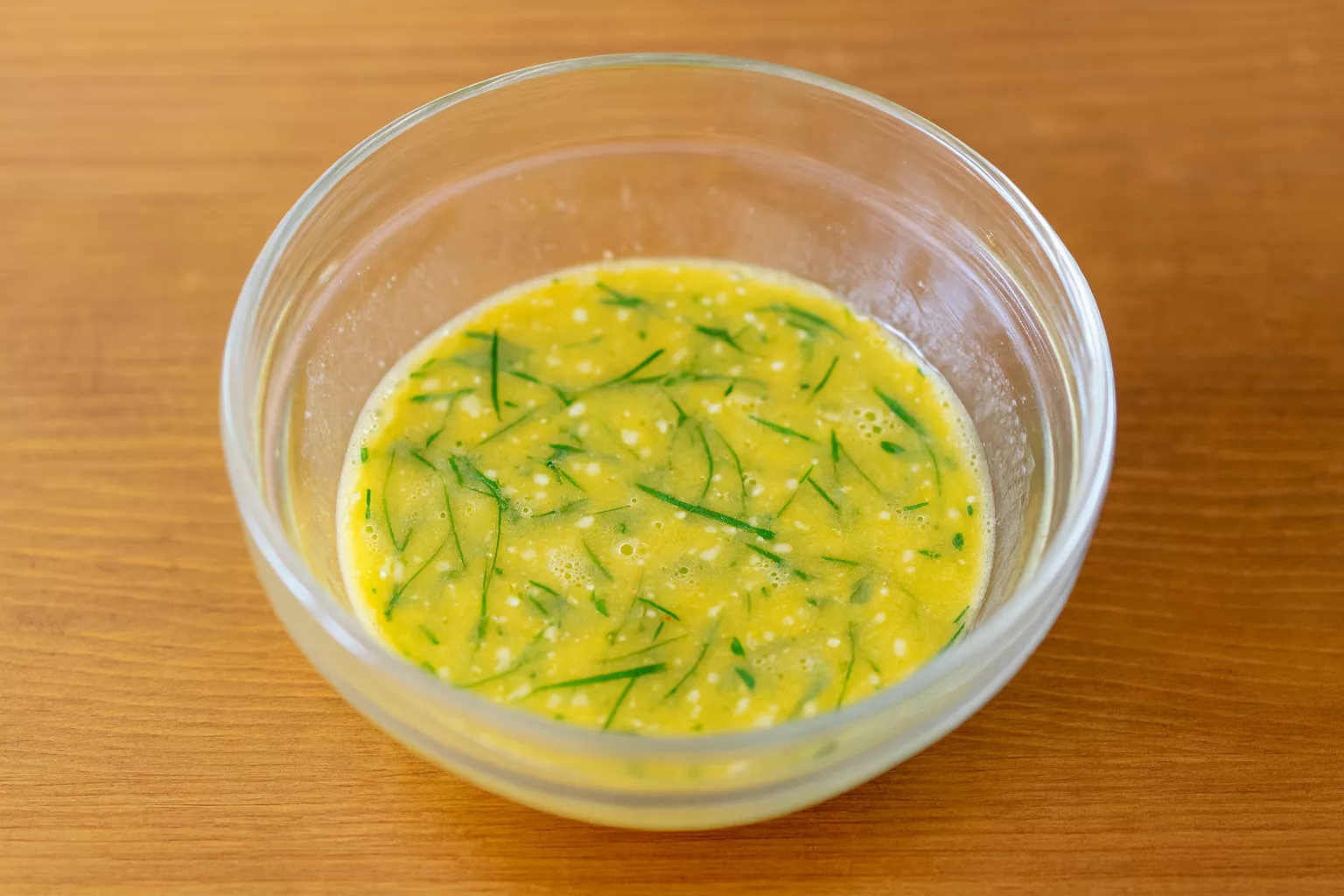
Cooking Tamagoyaki
- Heat the Pan
Preheat your Tamagoyaki pan (or a small nonstick skillet) over low heat. Add a small amount of salad oil and use a paper towel to spread it evenly across the surface. This step prevents sticking and ensures smooth rolling. - First Layer
Pour about ⅓ of the egg mixture into the pan, swirling it to coat the bottom evenly. When the egg starts to set but is still slightly wet on top, gently lift one edge using chopsticks or a spatula and roll the omelet toward you. Don’t worry if the first roll looks uneven—this layer will be your base. - Second Layer
Push the rolled omelet to the far end of the pan. Add a few drops of oil again, and pour another ⅓ of the mixture into the pan. Lift the rolled omelet slightly so the new layer slides underneath. When it sets halfway, roll again toward you. - Final Layer
Repeat the same step with the remaining egg mixture. Keep the heat low so the eggs cook evenly without burning. The key is to roll while the eggs are still slightly moist, not dry. - Shape the Tamagoyaki
Once all layers are rolled, gently press the omelet with the spatula to shape it evenly. Turn off the heat and let it rest for a minute before slicing.
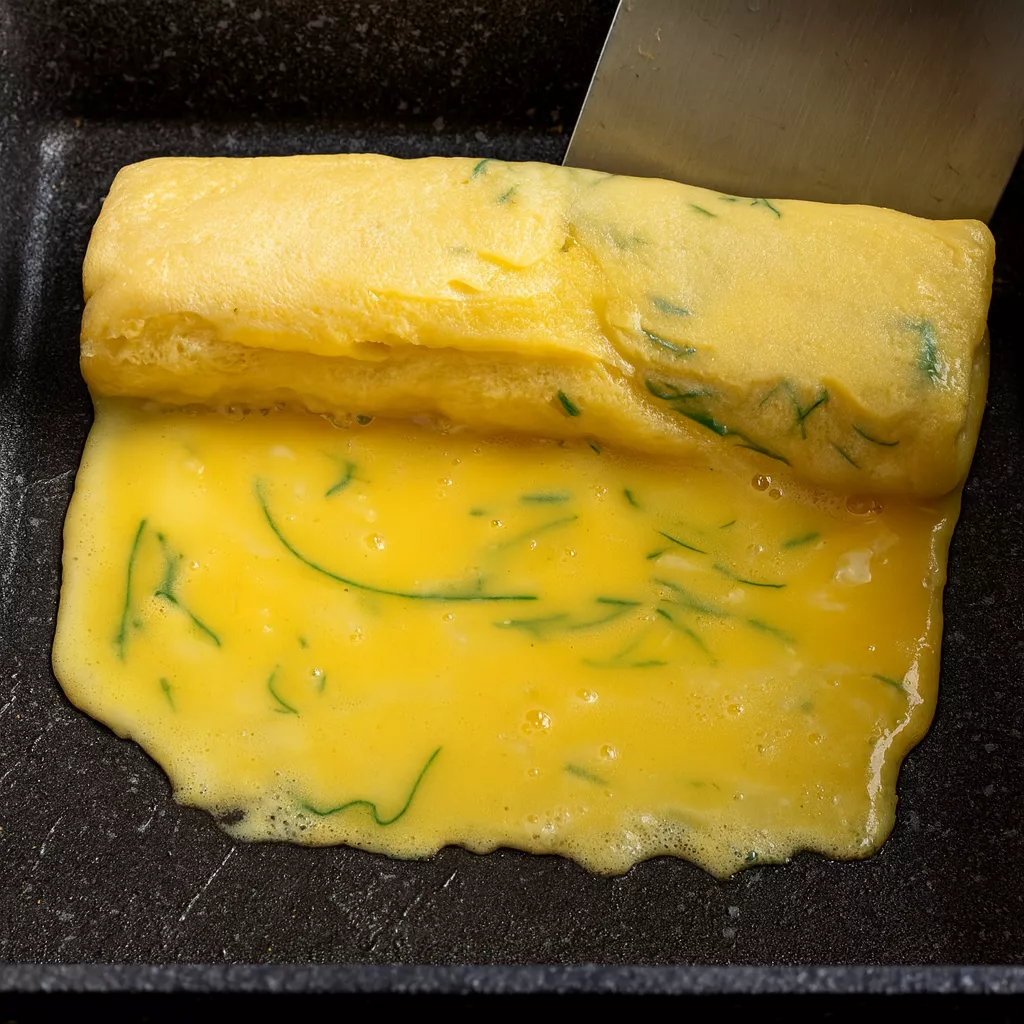
Secrets to Success and Expert Tips
- Low and Slow Heat: Cooking over low heat prevents browning and keeps the texture tender.
- Oil Between Layers: Always re-oil the pan lightly before adding each layer to avoid sticking.
- Do Not Overmix the Eggs: Overbeating adds too much air, creating holes or cracks.
- Cool Before Slicing: Let the Tamagoyaki rest briefly before cutting to help the layers hold together neatly.
- Use a Paper Towel Trick: After rolling, you can wrap the omelet in a paper towel and shape it gently while warm for a smooth, professional finish.
Once you understand these little secrets, your Tamagoyaki will have that silky texture and perfect roll that looks as good as it tastes.
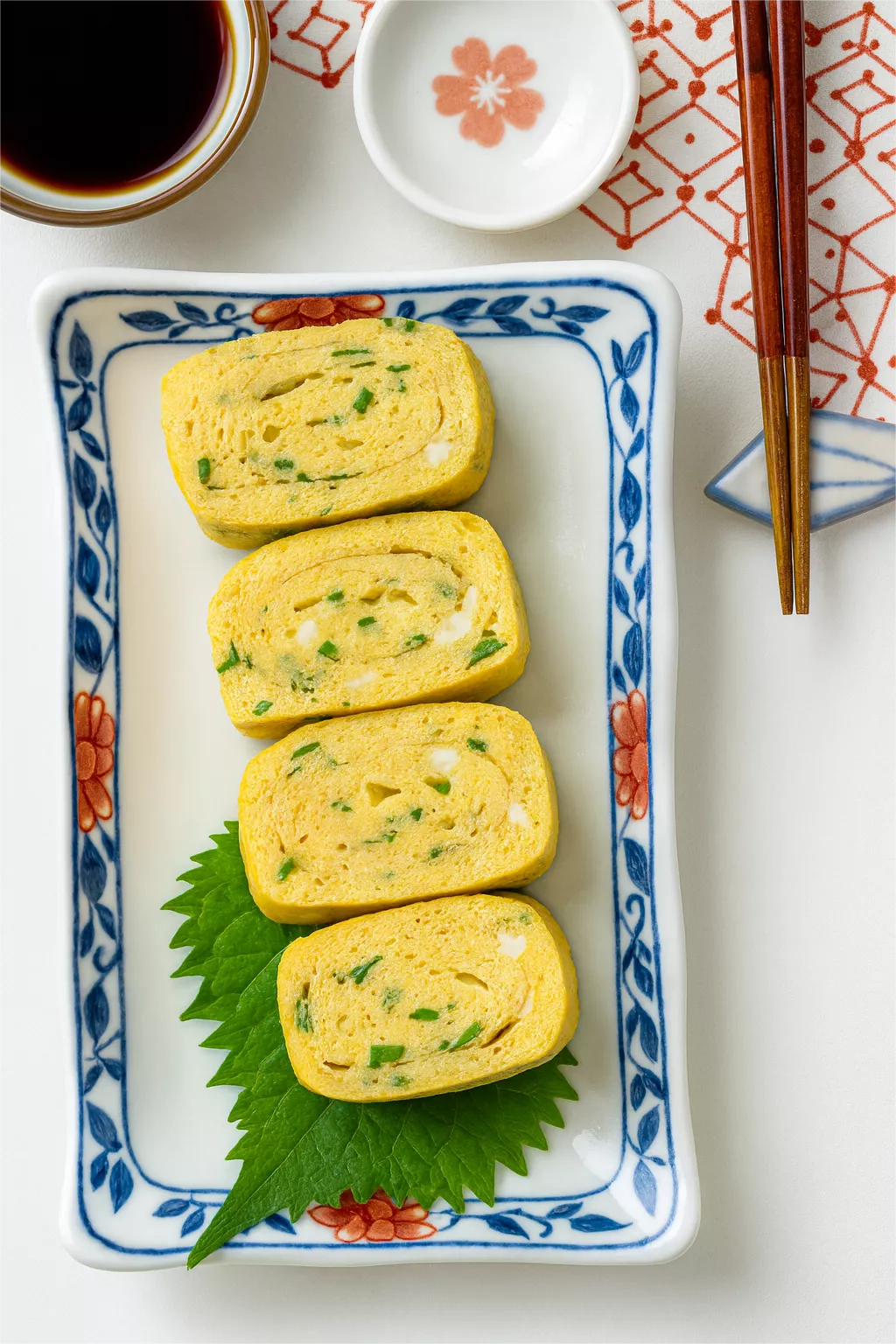
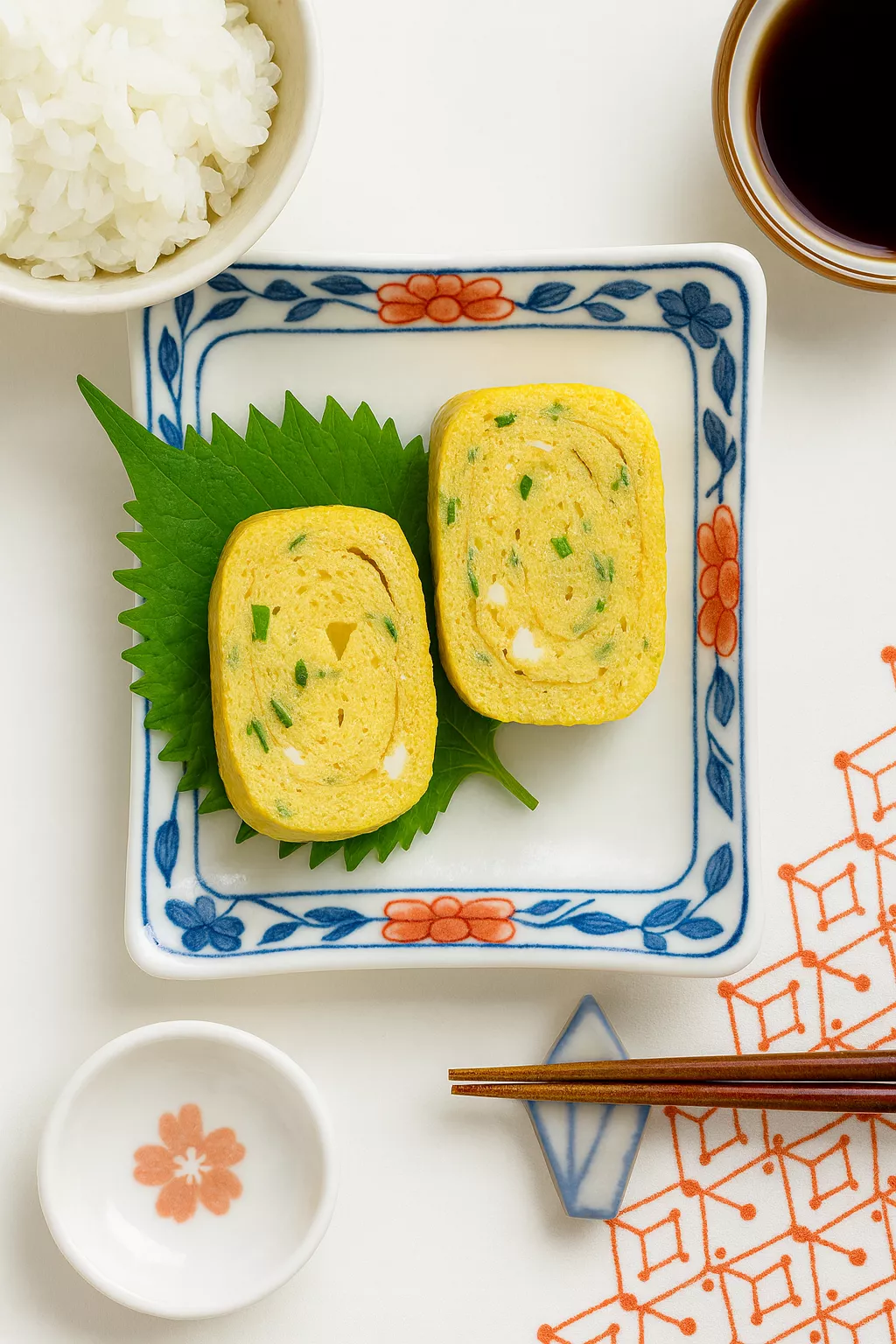
Assembly and Presentation
After the omelet cools slightly, transfer it to a clean cutting board. Use a sharp knife to slice it into 1-inch pieces. The cross-section should reveal beautiful layers with tiny bits of green shiso peeking through.
Serving Ideas
- Traditional Style: Serve with grated daikon and soy sauce.
- Bento Box: Slice into smaller pieces and place next to rice, pickles, and vegetables.
- Breakfast Plate: Pair with miso soup, steamed rice, and green tea for a full Japanese breakfast.
- Sushi Topping: Cut into rectangular blocks and serve on rice with nori for tamago sushi.
Hana’s Recipe Tips
- For a Softer Texture: Add 1 teaspoon of water to the egg mixture.
- For Extra Flavor: Sprinkle a pinch of sugar or a few drops of soy sauce depending on your taste.
- For a Pretty Finish: Wipe the pan edges clean between layers for a smooth look.
- For a Bento Lunch: Cool the omelet fully before packing—it keeps its shape and stays moist thanks to the mayonnaise.
Hana’s favorite trick? Always use chopsticks to roll rather than a spatula—it gives more control and helps create tighter layers.
Storage and Make-Ahead Tips
Tamagoyaki is best enjoyed fresh, but it can also be prepared ahead of time.
Here’s how to keep it delicious:
- Refrigeration: Store in an airtight container once cooled. It stays good for up to 2 days.
- Reheating: Warm gently in a microwave for 15–20 seconds or in a pan over low heat. Avoid overheating—it will dry out.
- Freezing: Not recommended, as freezing changes the texture and makes it spongy.
- For Bento Boxes: Pack only after cooling completely to avoid condensation that could make it soggy.
If you plan to make it in advance for breakfast or lunch, keep the rolled omelet whole and slice it just before serving. This helps retain moisture.
Recipe Pairing Ideas
Tamagoyaki pairs wonderfully with traditional Japanese comfort dishes. For a complete breakfast or lunch set, serve it alongside a warm bowl of Shio Ramen (塩ラーメン) — the mild, clear broth perfectly complements the slightly sweet flavor of the omelet. You can also enjoy it with Miso Soup (味噌汁) for a cozy, nourishing Japanese-style meal. Both combinations highlight the simplicity and balance that make Japanese home cooking so special.
Recipe Variations
Tamagoyaki is flexible—you can customize it easily:
- Sweet Tamagoyaki: Add 1 teaspoon sugar and reduce the mirin slightly. This version is popular in Tokyo.
- Savory Tamagoyaki: Replace mirin with soy sauce for a saltier flavor, common in Kansai.
- Vegetable Tamagoyaki: Add finely chopped carrots, spinach, or green onions for color and nutrients.
- Seafood Tamagoyaki: Add tiny bits of crab stick or shrimp for extra umami.
- Cheese Tamagoyaki: Sprinkle shredded cheese before rolling for a creamy twist.
- Spicy Tamagoyaki: Mix a few drops of chili oil or a pinch of togarashi for heat.
If you enjoy Japanese-style fusion recipes, you might also love our Chicken Onigirazu (鶏おにぎらず) a delicious rice sandwich filled with juicy chicken and flavorful seasonings.
And also Grilled Sanma 焼きサンマ. It’s another easy Japanese comfort food that pairs perfectly with Tamagoyaki in a bento box.
Conclusion
Now that you know how to make Tamagoyaki (玉子焼き), you can enjoy this Japanese comfort dish anytime. It’s soft, flavorful, and visually beautiful—a perfect example of how simple ingredients can create something truly special.
Whether served for breakfast, packed in a bento, or shared with friends, Tamagoyaki brings warmth and a touch of Japan to your table. Once you’ve mastered the basic roll, don’t hesitate to experiment with flavors and fillings to make it your own.
So next time you’re craving something quick, healthy, and satisfying, reach for your eggs and pan—because your homemade Tamagoyaki is just a few rolls away!
If you love exploring Japanese culture and hidden destinations, check out Kamishikimi Kumanoza Shrine – 5 Hidden Facts You’ll Love on JapanToVisit.com — a magical place that perfectly captures the peaceful beauty behind Japan’s traditional spirit.
FAQs
1. What is the difference between Tamagoyaki and Dashimaki Tamago?
Tamagoyaki uses a simple egg mixture with sugar and mirin, while Dashimaki Tamago includes dashi stock for a more savory, moist texture. The technique is similar, but the flavor is richer in Dashimaki.
2. Can I make Tamagoyaki without a rectangular pan?
Yes! You can use a small round nonstick pan. Just roll the egg toward one side as you would in a rectangular pan. The shape may differ slightly, but the taste will be the same.
3. Is Tamagoyaki healthy?
Absolutely. It’s high in protein, low in carbs, and rich in vitamins. Using shiso adds antioxidants and freshness. If you reduce the oil and sugar, it becomes a light and nutritious meal.
4. How can I keep Tamagoyaki soft after cooling?
Add mayonnaise or a small splash of water to the mixture. This retains moisture and prevents dryness, especially if you plan to pack it in a bento.
5. Can I add other ingredients?
Yes! You can mix in vegetables, nori (seaweed), or cheese for creative versions. Just keep fillings light to make rolling easier.
6. What do I serve with Tamagoyaki?
Traditionally, Tamagoyaki is served with miso soup, rice, grilled fish, or pickles. It also pairs beautifully with green tea or a side of fresh salad.
7. Why did my Tamagoyaki fall apart?
The most common reasons are rolling too soon, too late, or too dry. Roll the egg while it’s still slightly moist and always use low heat for even cooking.
Final Thoughts
Learning how to make Tamagoyaki (玉子焼き) is more than just a recipe—it’s an introduction to Japanese home cooking. With a few simple ingredients and a little practice, you can create a dish that’s warm, elegant, and deeply satisfying.
Now go ahead—pick up your pan and make your first roll. You might just find yourself falling in love with the art of Tamagoyaki.
Tamagoyaki (玉子焼き) – Easy Japanese Rolled Omelet Recipe
Course: AppetizersCuisine: JapaneseDifficulty: Easy2
servings10
minutes10
minutes~150
kcalTamagoyaki (玉子焼き) is a fluffy, layered Japanese rolled omelet that’s slightly sweet, savory, and full of umami flavor. Made with eggs, white dashi, mirin, and a touch of mayonnaise for softness, it’s perfect for breakfast, bento boxes, or as a sushi topping.
Ingredients
2 medium eggs
1 tablespoon mayonnaise
1 tablespoon white dashi (or substitute 1 tsp soy sauce + pinch of sugar)
1 tablespoon mirin
4 shiso (perilla) leaves, washed and finely sliced
Salad oil, as needed for frying
Directions
- Prepare the shiso.
Rinse the shiso leaves gently, pat them dry, and cut them into thin julienne strips. - Make the egg mixture.
In a medium bowl, whisk together the eggs, mayonnaise, white dashi, mirin, and sliced shiso until the mixture is smooth but not foamy. - Heat the pan.
Warm a Tamagoyaki pan or a small nonstick skillet over low heat. Add a small amount of salad oil and spread evenly with a paper towel. - Cook the first layer.
Pour about one-third of the egg mixture into the pan, tilting to cover the surface. When the egg begins to set but is still moist, gently roll it toward you with a spatula or chopsticks. - Add the next layers.
Push the rolled egg to the far side of the pan. Oil the surface lightly again. Pour another third of the egg mixture, letting it flow under the first roll. When half-set, roll again. Repeat with the final third of the mixture. - Shape and rest.
Once rolled, press the Tamagoyaki gently to shape it evenly. Let it rest for 1–2 minutes, then transfer to a board and slice into 1-inch pieces.
Notes
- ✪ Secrets to Success: Keep the heat low, add a thin coat of oil between layers, and roll while the egg is still slightly wet for the best texture.
✪ Hana’s Recipe Tip: Wrap the finished Tamagoyaki in a paper towel while it’s warm to create smooth, even edges.
✪ Storage: Store cooled pieces in an airtight container in the refrigerator for up to 2 days. Reheat gently or enjoy cold.
